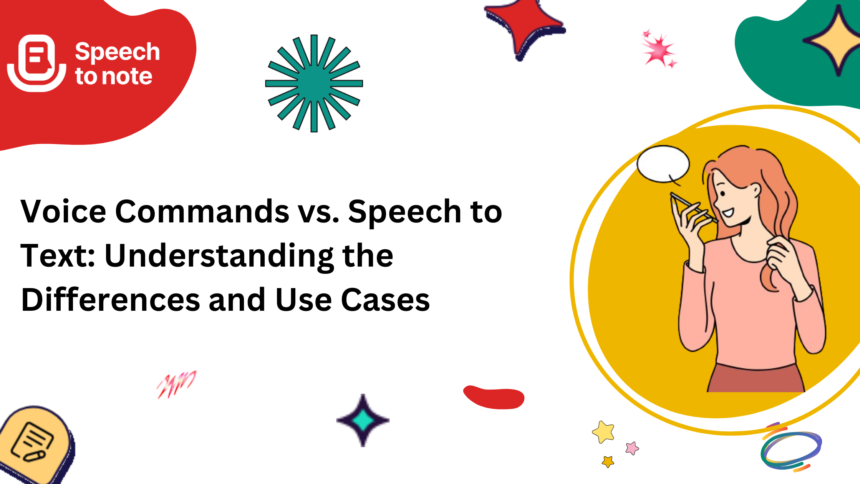Ever found yourself barking at your phone like it’s a stubborn dog, only for it to dial “Mom” instead of setting a reminder? Or tried speaking a text message, and watched in horror as “lunch with Sarah” turned into “launch missile, sir”? This is the curious world of voice technology—filled with amazing convenience but also its fair share of comical misunderstandings. And while voice commands and speech-to-text might seem like two sides of the same tech coin, they’re actually very different.
In this article, we’ll dig into what sets voice commands apart from speech-to-text converters, uncover their unique uses, and show where a “voice to note app” fits in. Whether you’re a gadget enthusiast or just trying to boost productivity, let’s take a closer look at how these technologies differ and how to best use each.
What is a Voice Command, and Why is It So Popular?
Voice commands are essentially quick, spoken shortcuts for performing specific tasks on your device. You say, “Play my favorite playlist,” and your phone or smart speaker springs into action, delivering tunes without a single tap. It’s quick, intuitive, and perfect for hands-free moments—like when you’re cooking or driving.
Voice commands rely on pre-programmed responses to particular phrases, which means they’re built for efficiency, not deep conversations. Ask a virtual assistant to “turn on the lights” or “set an alarm,” and it’ll do just that. But try explaining that you need a reminder for “next Tuesday, not this Tuesday,” and you might get a little lost in translation.
What makes voice commands so popular? They’re easy! According to a study by Adobe, 48% of people who use voice commands say it makes tasks easier and faster. And let’s face it, there’s something fun about talking to your device and having it respond—almost like a scene straight out of sci-fi.
Speech to Text: The Talk-and-Type Revolution
Now, let’s shift gears to speech-to-text. If voice commands are about getting things done, speech-to-text is about getting your words down. A speech-to-text converter doesn’t just respond to preset commands; it listens to what you say and translates your speech into written words. Think of it as your digital scribe, transcribing everything from notes on speech during a meeting to the random thoughts you want to capture.
A great example of a speech-to-text converter in action is when journalists or students need quick and accurate notes. Instead of scribbling feverishly, they can just speak into their devices, using an app to transform voice to note, thus freeing them up to focus on the conversation. This technology is perfect for creating written documentation without the manual effort of typing, making it invaluable for people across various fields—from entrepreneurs to legal professionals.
Unlike voice commands, though, speech-to-text apps require more processing power. They have to interpret entire sentences, figure out punctuation, and even pick up on contextual clues. Some advanced apps can even differentiate between homophones (words that sound alike but have different meanings) based on context—a game-changer for clarity.
Where Each Technology Shines
Both voice commands and speech-to-text have their sweet spots. Here’s where each one stands out:
- Voice Commands: Ideal for quick, direct actions. Want to set a reminder, ask for the weather, or make a hands-free call? Voice commands get it done fast. But it’s not built to capture long, nuanced thoughts or transcribe details; it’s best for simple tasks.
- Speech to Text: Perfect for capturing longer pieces of information. Need to take detailed notes on speech during a lecture, brainstorm out loud, or even transcribe an interview? That’s where a speech-to-text converter comes in handy. With the right app, you can even add punctuation by saying commands like “comma” or “period,” creating a more readable output.
Imagine, for instance, you’re a busy entrepreneur juggling ideas all day. You might use voice commands to set reminders and make calls, while a speech-to-text app would be your go-to for capturing in-depth notes or logging meeting details. Each technology has its place in the productivity toolkit.
The Power of the Voice to Note App in Real Life
So, where does a “voice to note app” fit into all this? Think of it as the best of both worlds. These apps combine the convenience of voice input with the precision of text output, offering a powerful tool for anyone who wants to make their words count. A good voice-to-note app doesn’t just transcribe—it organizes and stores your thoughts, making it easy to retrieve them later.
For example, imagine being an event planner juggling a million details. A voice-to-note app lets you dictate everything from client preferences to venue details, converting it into text that you can review and organize at your leisure. This kind of app helps turn spoken thoughts into structured notes, all without the frustration of using clunky interfaces or risking typos on tiny screens.
In 2022, the voice-to-note market was valued at over $10 billion and is only growing as more people discover the flexibility it provides for managing ideas on the go. The need for a seamless blend of speech-to-text functionality with easy access and organization has made this technology increasingly popular among professionals.
Practical Scenarios: When to Use Each Tool
To put this all into context, here are some scenarios showing the best ways to use each tool:
- Voice Commands for the Busy Parent: Imagine you’re knee-deep in toddler chaos, and you need to make a quick note without dropping everything. “Set reminder for tomorrow’s doctor appointment,” you tell your phone, and voilà—your assistant has it covered.
- Speech to Text for the Student: If you’re a student trying to keep up with fast-paced lectures, a speech-to-text converter can save you. Instead of scribbling notes, you speak, and the app captures everything, letting you stay present while ensuring nothing important slips by.
- Voice to Note App for the Entrepreneur: Running a business involves constant ideation, and not every idea waits until you’re at your desk. With a voice-to-note app, you can capture your thoughts wherever inspiration strikes and review them later, organized and ready to act upon.
Each tool shines in different situations, making it clear that voice commands, speech-to-text converters, and voice-to-note apps serve different purposes—and all have a unique role to play.
Wrapping It Up: Which Technology is Right for You?
In the end, both voice commands and speech-to-text offer unique benefits, depending on your needs. If you’re after a hands-free way to control your device, voice commands are a lifesaver. But if capturing your ideas or creating structured notes is the goal, then a speech-to-text converter or voice to note app will serve you best.
So, the next time you’re debating whether to talk to your phone, consider what you need. Is it a quick action or a long thought? A voice command may have you covered, but for those in-depth ideas, a voice-to-note app might just be your new best friend.
What about you? Do you find yourself using voice technology daily, or is it something you’re just starting to explore? Let us know in the comments! And who knows? You might just inspire someone else to dive into the world of voice tech.


